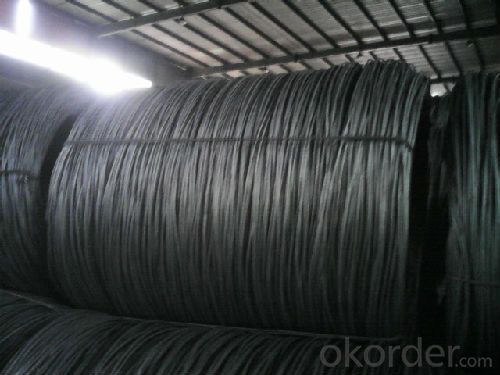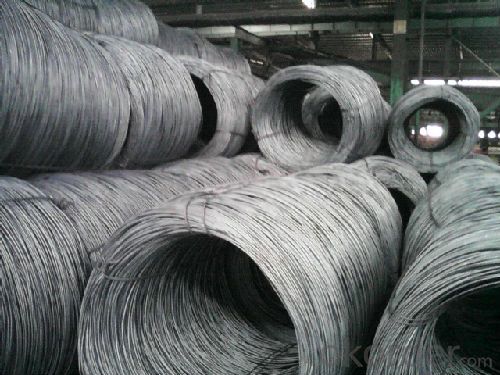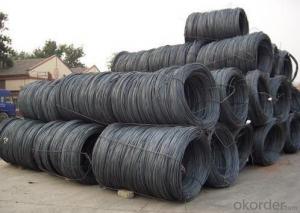Steel Wire Rod Coils Steel Hot Rolled Wire Rod Q195
- Loading Port:
- Tianjin
- Payment Terms:
- TT or LC
- Min Order Qty:
- 28 m.t.
- Supply Capability:
- 35000 m.t./month
OKorder Service Pledge
OKorder Financial Service
You Might Also Like
Product Description:
OKorder is offering Steel Wire Rod Coils Steel Hot Rolled Wire Rod Q195 at great prices with worldwide shipping. Our supplier is a world-class manufacturer of steel, with our products utilized the world over. OKorder annually supplies products to European, North American and Asian markets. We provide quotations within 24 hours of receiving an inquiry and guarantee competitive prices.
Product Applications:
Steel Wire Rod Coils Steel Hot Rolled Wire Rod Q195 are ideal for structural applications and are widely used in the construction of buildings and bridges, and the manufacturing, petrochemical, and transportation industries.
Product Advantages:
OKorder's Steel Wire Rod Coils Steel Hot Rolled Wire Rod Q195 are durable, strong, and resist corrosion.
Main Product Features:
· Premium quality
· Prompt delivery & seaworthy packing (30 days after receiving deposit)
· Corrosion resistance
· Can be recycled and reused
· Mill test certification
· Professional Service
· Competitive pricing
Product Specifications:
1.Hot-rolled steel wire rod for building/construction
2.Near the seaport,low logistic cost
3.High precision,5-12mm
Product |
wire rod |
| Standard | AISI, ASTM, BS, DIN, GB, JIS |
| Material/steel grade | Q195-Q235,SAE1006B, SAE1008B, SAE1010B, SAE1018B, or according to customers requirements |
| Wire Gauge | 5.5-12mm |
| Coil weight | 1.8-2.1mts |
| MOQ | 25MT |
| Delivery Time | 15-30 days after receipt of L/C or deposit by T/T |
| Packing | In coil and load in container, if large quantity, by bulk vessel; Can be packed as customers' special requirements |
| Payment terms | 1).100% irrevocable L/C at sight. 2).30% T/T prepaid and the balance against the copy of B/L. 3).30% T/T prepaid and the balance against L/C |
| Application | widely used in machinery parts, manufacturing industry, electronics industry, metal tools and others |
FAQ:
Q1: Why buy Materials & Equipment from OKorder.com?
A1: All products offered byOKorder.com are carefully selected from China's most reliable manufacturing enterprises. Through its ISO certifications, OKorder.com adheres to the highest standards and a commitment to supply chain safety and customer satisfaction.
Q2: How do we guarantee the quality of our products?
A2: We have established an advanced quality management system which conducts strict quality tests at every step, from raw materials to the final product. At the same time, we provide extensive follow-up service assurances as required.
Q3: How soon can we receive the product after purchase?
A3: Within three days of placing an order, we will begin production. The specific shipping date is dependent upon international and government factors, but is typically 7 to 10 workdays.




- Q:How is steel wire rod used in the manufacturing of reinforcing mesh?
- Steel wire rod is used in the manufacturing of reinforcing mesh by being stretched and shaped into a grid pattern. This grid pattern is then welded together to form a strong and durable mesh that is used to reinforce concrete structures such as buildings, bridges, and roads. The steel wire rod provides the necessary strength and stability to the reinforcing mesh, making it an essential component in the construction industry.
- Q:How are steel wire rods used in the production of wire springs for mechanical devices?
- Steel wire rods are used in the production of wire springs for mechanical devices by being shaped and coiled into the desired spring shape. The high tensile strength and durability of steel make it a suitable material for creating springs that can withstand repeated compression and extension. The wire rods are typically heated, drawn through a die to achieve the desired diameter, and then coiled into the specific spring shape. This process ensures that the resulting wire springs can effectively store and release energy, providing the necessary mechanical functionality in various devices.
- Q:How does the recycling process affect the mechanical properties of steel wire rod?
- The recycling process of steel wire rod can have both positive and negative effects on its mechanical properties. One of the main advantages of recycling steel wire rod is that it helps conserve natural resources and reduce the overall carbon footprint of the steel industry. By using scrap steel as a raw material, the recycling process can save energy and reduce emissions associated with mining and processing iron ore. This conservation of resources and reduction in energy consumption can indirectly contribute to the mechanical properties of the recycled steel wire rod. However, the recycling process can also introduce impurities and alloying elements that may affect the mechanical properties of the steel wire rod. During the melting and refining stages of the recycling process, impurities such as sulfur, phosphorous, and non-metallic inclusions can be introduced into the steel composition. These impurities can have adverse effects on the mechanical properties, such as reducing ductility, toughness, and fatigue strength. In addition, the recycling process may also lead to changes in the microstructure of the steel wire rod. The repeated heating and cooling cycles during melting, casting, and rolling can alter the grain size, grain boundaries, and phase distribution within the steel. These changes can impact the mechanical properties of the steel wire rod, such as its hardness, tensile strength, and elongation. To mitigate the potential negative effects of the recycling process on the mechanical properties of steel wire rod, various techniques and processes can be implemented. For instance, advanced refining methods can be employed to reduce impurities and control the chemical composition of the recycled steel. Additionally, heat treatment processes can be used to optimize the microstructure and improve the mechanical properties of the steel wire rod. Overall, while the recycling process of steel wire rod has the potential to impact its mechanical properties, with proper quality control measures and optimization techniques, the recycled steel can still meet the required mechanical specifications for various applications.
- Q:What are the main components of a steel wire rod mill?
- The main components of a steel wire rod mill include a reheating furnace, roughing mill, intermediate mill, finishing mill, cooling bed, and coiling machines. The reheating furnace is used to heat the raw material, which is typically billets or ingots, to a temperature suitable for rolling. This helps in reducing the material's brittleness and improving its plasticity. The roughing mill is responsible for reducing the thickness of the heated material through a series of rolling passes. It consists of multiple stands of rolls that gradually decrease the size of the material. After the roughing mill, the material is passed through the intermediate mill. This mill further reduces the thickness and improves the surface quality of the wire rod. The finishing mill is the final stage of the rolling process. It consists of several stands of rolls that give the wire rod its final dimensions and surface finish. This mill is crucial in achieving the desired mechanical properties and dimensional accuracy of the wire rod. Once the wire rod is rolled to the desired shape and size, it is then transferred to the cooling bed. The cooling bed allows the wire rod to cool down gradually, preventing any deformation or cracking due to the high temperatures from the rolling process. Finally, the coiling machines are used to coil the wire rod into spools or coils, making it easier for transportation and storage. Overall, these main components work together in a steel wire rod mill to transform raw materials into high-quality wire rods that can be used in various industries such as construction, automotive, and manufacturing.
- Q:How is the steel wire rod market expected to grow in the future?
- The steel wire rod market is expected to witness steady growth in the future due to several factors. Increasing infrastructure development projects and construction activities worldwide will drive the demand for steel wire rods for reinforcement purposes. Additionally, the growing automotive industry and the need for lightweight, fuel-efficient vehicles will further boost the market. Moreover, the rising demand for steel wire rods in electrical power transmission and manufacturing sectors will contribute to the market's growth. However, the market may face challenges such as fluctuating raw material prices and environmental concerns. Overall, the steel wire rod market is anticipated to expand in the coming years, supported by various end-use industries.
- Q:How is steel wire rod used in the manufacturing of wire forms for automotive components?
- Steel wire rod is an essential component in the manufacturing of wire forms for automotive components. Wire forms are intricate shapes and designs made from metal wire, and they play a crucial role in various automotive applications such as springs, clips, brackets, and fasteners. The process begins with steel wire rods, which are typically made from carbon or alloy steel. These rods serve as the raw material for wire drawing, which is the primary method used to produce wire forms. Wire drawing involves pulling the steel wire rod through a series of dies to reduce its diameter and increase its length. This process helps to improve the wire's tensile strength and surface finish, making it suitable for automotive applications. Once the desired wire diameter is achieved through wire drawing, it is then fed into specialized machinery to create different wire forms. This machinery includes automated CNC (Computer Numerical Control) machines that can bend, shape, and cut the wire according to precise specifications. These machines use different tools and dies to form wire into the desired shape, ensuring accuracy and consistency. Wire forms manufactured from steel wire rod offer several advantages for automotive components. Firstly, steel wire rods provide excellent strength and durability, making them suitable for handling the demanding conditions within automotive systems. They can withstand high temperatures, vibrations, and mechanical stresses, ensuring the wire forms maintain their structural integrity over time. Moreover, steel wire rods offer flexibility in terms of design and customization. Manufacturers can easily create wire forms of various sizes, shapes, and configurations to meet the specific requirements of different automotive components. This versatility allows for the production of wire forms that are tailored to fit the precise needs of the automotive industry, enhancing the overall performance and functionality of the components. Additionally, steel wire rods are cost-effective and readily available, making them a preferred choice for wire form manufacturing in the automotive sector. The abundance of steel as a raw material ensures a stable supply chain, allowing manufacturers to meet the high demands of the automotive industry efficiently. In conclusion, steel wire rod is a crucial component in the manufacturing of wire forms for automotive components. Through the process of wire drawing and specialized machinery, steel wire rods are transformed into intricate shapes and designs that provide strength, durability, and flexibility. This enables the production of wire forms that meet the stringent requirements of automotive applications, ultimately contributing to the overall functionality and performance of automotive components.
- Q:What are the main properties of steel wire rod?
- The main properties of steel wire rod include high tensile strength, excellent ductility, good corrosion resistance, and high thermal conductivity. It is also known for its versatility and ability to be easily formed and shaped into various products. Additionally, steel wire rod has a high melting point and is highly resistant to wear and tear, making it ideal for applications that require durability and strength.
- Q:How does the fatigue strength of steel wire rod vary with different heat treatment processes?
- The fatigue strength of steel wire rod can vary with different heat treatment processes. Heat treatment processes like annealing, quenching, and tempering can significantly affect the microstructure and mechanical properties of steel wire rod, including its fatigue strength. Annealing, for example, can help reduce internal stresses and improve the ductility of the wire rod, thus potentially increasing its fatigue strength. Quenching and tempering, on the other hand, can enhance the hardness and strength of the wire rod, but may also result in reduced ductility and potentially lower fatigue strength. Therefore, the specific heat treatment process used on steel wire rod can have a significant impact on its fatigue strength.
- Q:What is the standard length of steel wire rod?
- The specific industry and application play a role in determining the standard length of steel wire rod. Typically, lengths between 5.5 meters and 12 meters are produced. Nevertheless, it should be emphasized that customer-specific lengths can be manufactured upon request. Factors like intended use, manufacturing process, and transportation logistics contribute to determining the length of the steel wire rod.
- Q:What are the main factors influencing the choice of steel wire rod order return policy?
- The main factors influencing the choice of steel wire rod order return policy include customer satisfaction, market demand, product quality, legal requirements, and the company's overall business strategy.
1. Manufacturer Overview |
|
|---|---|
| Location | |
| Year Established | |
| Annual Output Value | |
| Main Markets | |
| Company Certifications | |
2. Manufacturer Certificates |
|
|---|---|
| a) Certification Name | |
| Range | |
| Reference | |
| Validity Period | |
3. Manufacturer Capability |
|
|---|---|
| a)Trade Capacity | |
| Nearest Port | |
| Export Percentage | |
| No.of Employees in Trade Department | |
| Language Spoken: | |
| b)Factory Information | |
| Factory Size: | |
| No. of Production Lines | |
| Contract Manufacturing | |
| Product Price Range | |
Send your message to us
Steel Wire Rod Coils Steel Hot Rolled Wire Rod Q195
- Loading Port:
- Tianjin
- Payment Terms:
- TT or LC
- Min Order Qty:
- 28 m.t.
- Supply Capability:
- 35000 m.t./month
OKorder Service Pledge
OKorder Financial Service
Similar products
New products
Hot products
Related keywords



























